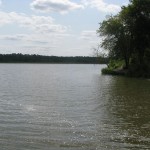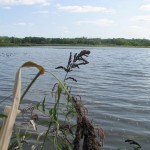Minnesota River
The Minnesota River was home to the Dakota people just as the Mississippi River was home. The Dakota word for village is “Otunwe.” Many times, the villages were named after the local leader. Can you find out the names of some Dakota villages on the Minnesota River?
Dakota villages were permanent sites where people farmed during the summer months each year. At the end of the summer, grain would be stored underground in the villages, and people would leave to hunt for the winter. At the beginning of the next summer, people would return, repair their homes if needed, and use the stored grain as they grew the next year’s crops. From time to time, village sites would move as people responded to changes in the land and political situations. The Minnesota River was an easily-used means of communicating and traveling among many of the Dakota villages.
In addition to villages, many sacred sites are located along the Minnesota River. These sites were often kept hidden from outsiders, and some are being cared for by Dakota people now.
By 1862, all Dakota people who had once lived in a 5-state region were confined to a small strip of land on either side of the Minnesota River. In that year, the Dakota War took place up and down the Minnesota River, as Dakota people responded to treaty violations that left them without food.
Sample reading (from Wikipedia) – The Dakota War of 1862 (also known as the Sioux Uprising, Sioux Outbreak of 1862, the Dakota Conflict, the U.S.-Dakota War of 1862, or Little Crow’s War) was an armed conflict between the United States and several bands of the eastern Sioux or Dakota which began on August 17, 1862, along the Minnesota River in southwest Minnesota and ended with a mass execution of thirty-eight Dakota on December 26, 1862, in Mankato, Minnesota. Throughout the late 1850s, treaty violations by the United States and late or unfair annuity payments by Indian agents caused increasing hunger and hardship among the Dakota. Traders with the Dakota previously had demanded that annuity payments be given to them directly (introducing the possibility of unfair dealing between the agents and the traders), but in mid-1862, the Dakota demanded the annuities directly from their agent, Thomas J. Galbraith. The traders refused to provide any more supplies on credit. Thus negotiations reached an impasse as a result of the bellicosity of the traders’ representative, Andrew Myrick, who suggested that the Sioux could eat grass or their own excrement if they were hungry. [1] On August 17, 1862, five American settlers were killed by four Dakota on a hunting expedition. That night, a council of Dakota decided to attack settlements throughout the Minnesota River valley in an effort to drive whites out of the area. Continued battles between the Dakota against settlers and later, the United States Army, ended with the surrender of most of the Dakota forces. [2] There has never been an official report on the number of settlers killed, but estimates range from 400 to 800. Historian Don Heinrich Tolzmann says until the terrorist attacks of Sept. 11, 2001, it was the highest civilian wartime toll in U.S. history (excluding then the Civil War). [3] By late December, more than a thousand Dakota were interned in jails in Minnesota, and 38 Dakota were hanged in the largest one-day execution in American history on December 26, 1862. In April 1863, the rest of the Dakota were expelled from Minnesota to Nebraska and South Dakota, and their reservations were abolished by the United States Congress.
Select the audio file, “How to pronounce Mnisota,” to the right to hear Dakota people pronounce the word(s) Mnisota. Select the “Cloudy Waters” audio file to hear Dakota voices relay historic stories and personal experiences with the river. The audio is the primary audio (approx. 26 minutes long) of the exhibit installation at the Minnesota Historical Society, “Cloudy Waters; Dakota Reflections on the River.” The audio is best with headphones.





